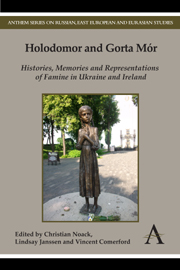Book contents
- Frontmatter
- Contents
- List of Figures
- Acknowledgements
- Introduction Holodomor and Gorta Mór: Histories, Memories and Representations of Famine in Ukraine and Ireland
- Part I Histories, Historiography and Politics
- Part II Public Commemoration
- Part III Trauma and Victimisation
- Chapter 8 Holodomor and the Politics of Memory in Ukraine after Independence
- Chapter 9 The Great Irish Famine in Stories for Children in the Closing Decades of the Twentieth Century
- Chapter 10 Collective Trauma in a Feature Film: Golod-33 as One-of-a-Kind
- Part IV New Sources and New Approaches to the Irish and Ukrainian Famines
- Index
Chapter 10 - Collective Trauma in a Feature Film: Golod-33 as One-of-a-Kind
from Part III - Trauma and Victimisation
Published online by Cambridge University Press: 05 May 2013
- Frontmatter
- Contents
- List of Figures
- Acknowledgements
- Introduction Holodomor and Gorta Mór: Histories, Memories and Representations of Famine in Ukraine and Ireland
- Part I Histories, Historiography and Politics
- Part II Public Commemoration
- Part III Trauma and Victimisation
- Chapter 8 Holodomor and the Politics of Memory in Ukraine after Independence
- Chapter 9 The Great Irish Famine in Stories for Children in the Closing Decades of the Twentieth Century
- Chapter 10 Collective Trauma in a Feature Film: Golod-33 as One-of-a-Kind
- Part IV New Sources and New Approaches to the Irish and Ukrainian Famines
- Index
Summary
The subject of the Ukrainian Famine is so intensely distressing that any critique of its representation in the arts runs the risk of being mistaken as an attempted denial of the fact of the Famine itself. The term ‘Holodomor’, coined during the 1980s by the Ukrainian diaspora in North America to describe the intentional extermination of people on a massive scale through hunger, has since become a cornerstone in the process of state building in independent Ukraine and in the formation of a national identity.
It goes without saying that events during the Famine in the early 1930s have been traumatic. In current discussions on the 1932–33 Famine, figures of up to 10 million victims are quoted. While the latter figure is certainly excessive, it is almost unconditionally taken for granted in the current Ukrainian historiographical mainstream, as Heorhiy Kasianov has shown. Still, any significant reduction of the number of victims would not alter the situation much, as we would still be dealing with millions of premature deaths. Unlike the victims of the Holocaust, those of the Ukrainian Famine still await an adequate visual representation of their sufferings.
- Type
- Chapter
- Information
- Holodomor and Gorta MórHistories, Memories and Representations of Famine in Ukraine and Ireland, pp. 197 - 212Publisher: Anthem PressPrint publication year: 2012
- 2
- Cited by



